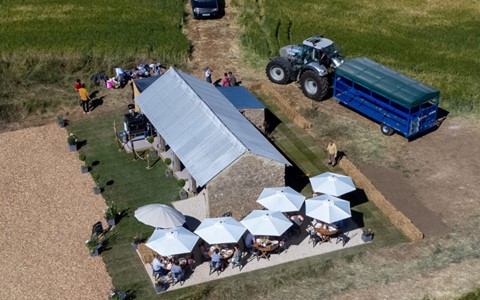Masterplanning - The Key to Long-Term Diversification Success?

In the ever-evolving landscape of rural enterprise, diversification is more than just a buzzword—it’s a strategic imperative. Rural businesses can no longer “stand still” and must adapt to thrive in times of uncertainty and change. However, to achieve this, they need to be fully aware of the long-term diversification opportunities available to them and create and execute plans on how best to capitalise on said opportunities, in a manner that doesn’t place unacceptable levels of risk on the business.
We believe that the concept of masterplanning serves as the cornerstone for long-term rural diversification success. But what exactly is masterplanning, and why do we think it’s crucial for farm or estate businesses? Let’s delve into the key components that make masterplanning an essential tool for innovative rural businesses, their sustainable growth, and realisation of multiple income streams.
“Start with Why” – Understanding the Aspirations, Motivations, and Objectives
The journey to successful long-term diversification begins with understanding your ‘why’, a concept familiarised by the brilliant Simon Sinek! Why do you want to diversify? What are your aspirations and motivations? Whether it’s to secure financial stability, increase resilience against market fluctuations, create employment opportunities, or leave a legacy for future generations, defining your objectives is the first crucial step.
Clear objectives will guide your masterplanning process, ensuring every decision aligns with your long-term vision.


Understand Your Business Context – Core Values, Skillsets, Existing Enterprises, Stakeholders, and Succession
Before diving into new ventures, it’s vital to understand your existing business context.
- Evaluate your current skillsets and resources—this will help identify potential areas for diversification that align with your strengths.
- Take stock of your existing enterprises and assess how they can complement new ventures. Can you create any enterprise stacking or add value to existing operations?
- What are the specifics surrounding stakeholders of the business? What are their needs and wants, and how are they utilised? Will this change over time?
- Lastly, consider succession. Long-term diversification should not only address current needs but also ensure the continuity and growth of the business for future generations.
Understand the Wider Context – SWOT
Conducting a SWOT analysis (Strengths, Weaknesses, Opportunities, and Threats) is essential to understanding the wider context of a rural business and the opportunities available to it. Look at both the site-specific and surrounding factors:
- Strengths and Weaknesses: Identify internal factors such as location advantages, access, available infrastructure, and resource limitations. Can you lean into an “unfair advantage”?
- Opportunities and Threats: Examine external factors, including market trends, regulatory and planning changes, and local competition. Consider demographic shifts, access and routes to market.
Understanding these elements will help anticipate challenges, determine the viability of projects from an early stage, and allow rural businesses to leverage opportunities and focus resources effectively.


Plan for Opportunity – Identify and Lay Out Concurrent Projects Once Opportunities Are Identified
Once opportunities have been identified through the above processes, it’s time to plan for action! Finalise the masterplan by outlining concurrent projects, ensuring alignment with long-term objectives, and considering the factors discussed above. Consider the following:
- Prioritisation: Rank projects based on factors important to the business. e.g., available capital, ease of implementation, unlocking further opportunities. Projects should be successive and build momentum towards the overall objectives.
- Resource Allocation: Determine the resources required for each project and how they will be allocated.
- Timeline: Develop a realistic timeline for implementation, including key milestones and review points.
- Risk Management: Identify potential risks and develop mitigation strategies. This should be an ongoing and evolving process throughout the project’s duration.
A well considered masterplan will act as a high level roadmap, guiding and focusing rural businesses through the long-term diversification process while ensuring optimal resource use and minimising risk and distractions.
Masterplanning is complex and requires an understanding of various factors affecting rural businesses, and is a time-consuming process. However, it is indispensable for ensuring the long term success of an estate diversification strategy, which is often successive and compounding in nature.
At Dudley Peverill, we specialise in creating comprehensive masterplans tailored to the unique needs, circumstances and aspirations of our clients.
Get in touch with us today to learn more about our Estate Masterplanning Service and start your journey towards long-term diversification success.
Is Masterplanning of interest to you?
To help landowners gain clarity over the best route forward for their rural business, we provide strategic masterplanning to determine how they can optimise their asset use. We’d be delighted to have an informal, no-obligation initial consultation with you to determine how we can help you.
